 |
surfresearch.com.au
pollard : torquay slsc, 1995 |
| home | catalogue | history | references | appendix |
|
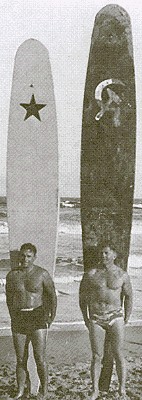 |
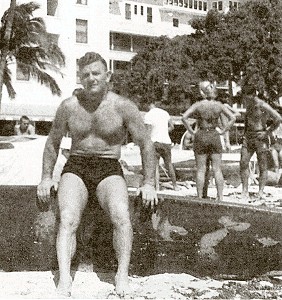 |
|
Torquay Beach, 1946. L. to R.: Ron Hussey, Dick Garrard. |
surf board rider Dick Garrard at Waikiki Beach Hawaii, 1954. |
The
Club Magazine.
In 1956 Graeme
Patrick, Carnival Organiser for the International and Australian Surf Carnivals,
introduced a monthly bulletin to keep members informed of the work taking
place for this huge commitment.
It was also used
to inform members of their rostered work dates etc.
From this beginning
he enlarged it into what became the club's magazine titled "Surf-Sun &
Sand". The magazine started out as a two page typed production, listing
all club events, carnival dates and so on.
A couple of advertisements
were even thrown in, mainly advertising where the new malibu boards could
be purchased.
Down the years
this magazine has progressed into a most sophisticated publication
Page 47
The two most prestigious and successful events conducted on the Torquay beach were the International and Australian Carnivals, held during the staging of the Olympic Games in Melbourne, November/December 1956.
The International
Carnival, in which teams from New Zealand, Ceylon, South Africa, Hawaii,
England, United States of America and Australia took part, was held on
Sunday, 25 November.
A crowd estimated
at 50,000 viewed this spectacle; the largest ever to witness a surf carnival
anywhere in Australia to that time.
It is doubtful
if that record has been broken to date of writing, 1995.
Pictures taken
at the time, show the spectators extending from the clubhouse to Pt. Danger,
and from the top of the sand dunes to beach level.
The total viewing
the of Australian Titles the following Sunday, 2 December, dropped substantially
due to the inclement weather and the delays experienced in getting home
from Torquay area the previous week.
There were reports
of vehicles stretching from Torquay to Geelong, bumper to bumper, and
for most of the
way to Melbourne.
Some reported
five hours to reach home.
However, the
event attracted well over thirty thousand spectators who applauded enthusiastically
the efforts of approximately 2,000 fit, young lifesavers.
The planning behind
these two carnivals was immense.
The club had
previously conducted Victorian Championships at its beach and the Southern
States Championships held during January 1954 was a great success, but
nothing resembling the magnitude of these two events had been undertaken.
It has been said
by many, that if they had envisaged the task ahead they would have never
attempted it.
However, being
naive and full of daring and confidence, plus a bit of showmanship on the
part of a few, the club forged ahead and what's more, put on a show that
won the members praise from around the Nation.
When it was announced in 1950 that Melbourne was to get the Olympic Games, plans were put in place by National Council in 1952 to have the sport of surf lifesaviving recognised as a ...
Page 48
... sports demonstration"
and thus give it Worldwide recognition.
Despite intense
representation from the Victorian end and at National level, a letter dated
28 July 1954 advised the club that the organising committee for the XVI
Olympiad Melbourne 1956 had rejected the submission and that the demonstration
sport selected, was to be Australian Rules Football.
Earlier, National
Council, had decided to push ahead with a "World or International" Carnival
and a letter to Jack Williams, Victoria State Centre Secretary, to that
effect, was sent on 8 March 1954.
It was also pointed
out in this letter, that to conduct the Australian Championships for 1956
during the period of the Games was out of the question due to the time
of the year, amongst other reasons. Finally, after many letters and phone
calls by Jack and direct representation by the Victorian Delegate, Ainslie
(Sprint) Walker, the Annual General Meeting of National Council in November
1954, passed a resolution "that Victoria could conduct both an International
and Australian Carnival Championships".
This was conveyed
to State Centre by letter dated 8 January 1955.
Prior to all this,
at a committee meeting of the club on 12 September 1954, it was moved by
club captain Clinton (Shacks) Shiells, seconded Alvin Caimey, "that this
Club make application for the Olympic Carnival in 1956. Venue to be decided
by State Centre 25/10/54."
A submission
was put together by Phillip Bennett, Jim Wall and Graeme Patrick and Eugene
(Titch) Cullity
presented the club's case to a panel of State Centre Officials.
The club was
notified on 29 October 1954 that they were successful and could conduct,
what was thought of at the time, a "World Carnival".
Clubs who had
submitted proposals were Lome, Portsea and Ocean Grove.
In earlier discussions,
there had been talk of holding one carnival at Torquay and one at Lome.
When it was announced
that Torquay would conduct both Carnivals, Lome made a number of attempts
to be allotted one and at State Centre meetings many heated discussions
ensued.
Pt. Lonsdale
backd the Lome submission, that a new ballot take place.
The logistics
of setting up two beaches, the extra travelling involved etc., saw sanity
prevail and in July 1955 it was again confirmed that both Carnivals would
be at Torquay.
Despite this little piece of uncertainty, the organising committee consisting of Jim Wall Supervising Chairman -Milton Napthine (Portsea Club), Chairman Showgrounds Camp Committee, Ainslie (Sprint) Walker, Chairman Welfare and Reception Committee, and Graeme Patrick, Director of Carnivals and Competition and Public Relations, was fully operational.
As early as June
1954, National Council had given the go ahead for State Centre to book
accommodation for 1,000 participants.
Negotiations
had been taking place with the Royal Agriculturaf Society of Victoria,
and that organisation advised the committee in November 1954 that the Halls
of Manufactures and Agricultural were available for their use, free of
charge.
This was a generous
gesture from the Society and as the planning took hold, the organising
committee were often overwhelmed with the generosity extended to the Surf
Life Saving movement by' many varied companies and individuals.
Milton Napthine
was a dedicated chairman of the Showgrounds Camp Organising Committee and
after repeated applications to a wide variety of Government bodies he organised
the loan of pillows, pillow cases and sheets from the Department of Air
plus 350 folding metal stretchers, and from the Department of Supply, 3,000
blankets, 100 wash basins, 400 beside tables, 400 mattresses and 400 mattress
covers.
The wonder of
all this was that in the final audit, with the exception of 40 blankets,
15 pillows and 20 or so broken stretchers, all of this equipment was returned
intact to the Departments named.
Though accommodation
had been arranged for 1,000, the final tally billeted at the Showgrounds
was 316.
The rest of the
1,700 competitors and strappers were scattered throughout Melbourne, Torquay,
Anglesea, Geelong, Barwon Heads, Ocean Grove etc.
The camp ran
from Wednesday, 21 November until 3 December, at a cost of £12.10.0
per person (approximately $26) and included bed and breakfast only.
A cut lunch was
provided if required ...
Page 50
... and a-la-carte
evening meals were served.
Milton and his
team provided laundry facilities, bank, post office, telephones, first
aid, showers, toilets, kiosk, identity and pass out cards.
Training facilities
were arranged for swimmers at the Footscray City Baths, and surfboat, ski
and
board competitors
trained at suburban beaches or the Maribyrnong River.
The transport
of personnel from the Showgrounds to Torquay and back again, was in itself
a mammoth operation, but it was done with the aid of buses from various
companies around Melbourne at a charge of 15/- ($1.50) per person for return
fare.
Work on the beach
and surroundings at Torquay was deemed necessary and plans were drawn up
by various engineers at the Geelong Harbour Trust free of charge.
They showed the
cost for a sea wall to help prevent the erosion taking place, plus the
grading of the cliff face and various ancillary works.
Appeals for money
for these projects to both the Federal and State Governments were rejected.
A committee was
formed in February 1955 incorporating all the local authorities to ensure
their co-operation and to keep them informed.
This group consisted
of members from the South Barwon and Barrabool Shires, Torquay Foreshore
and the Progress Traders Association.
Under the chairmanship
of Jim Wall, they met on frequent occasions and the aid extended to the
club by all these organisations was invaluable.
It was initially
established that no monies would be coming from any Government Department
to help in any way, so the club would have to go it alone and do the best
they could.
Finally, a sea
wall was built for approximately 22 metres in front of the club with a
small grant from the Department of Works, and was finished in October 1956.
With the Carnivals
fast approaching, the club formed a Carnival sub-committee, comprising,
under the chairmanship of Ralph Dean, Ron Gilbert, Alvin Cairney, Alan
Coulson, Brian Whiting, Eugene CuUity, Clinton Shiells and Rex (China)
Gilbert.
They were to
report to the committee on a monthly basis, and co-opt other members as
required.
In October, work
gangs of club members levelled the top of the cliff near the clubhouse
and toilets, in the form of trenches were excavated at the base of the
sand dunes.
The beach was
...
Page 51
... laid out,
and on the following weekends, fences and gates were erected by Fred Payne
and his men in preparation for the hundreds of yards of hessian to be put
in place.
Army signallers
wired the area for sound and telephones for the press were installed.
Sid Baker and
Percy Mann organised gate keepers plus ticket and program sellers.
Sid also sent
men from his Geelong factory to erect a large grandstand, which was shipped
down from generosity of National Council, consisting of 15 rows of tiered
seating in three layers, seating 936 people.
Cost per seat
to the public was £2/2/- ($5).
Extra showers
were installed at the rear of the clubhouse with new interior lining, wiring
and painting of the clubhouse hastily carried out.
Visits were paid
to Melbourne and Torquay during all of this planning by National Council
Secretary, Ken Watson and National Superintendent, Vic Bessimo; their advice
and help in all matters was of the utmost benefit to the various organising
committees.
Ken Watson handled
the invitations to the touring teams and sent numerous detailed letters,
on a huge variety of matters, to Jack Williams and Graeme Patrick, that
ensured the smooth overall success of the two Carnivals.
However, there
were times when problems seemed insurmountable, but fortunately Torquay
had at the top, men of talent, dedication, diplomacy and perseverance.
Graeme Patrick
was one of these men.
Originally elected
as Public Relations Officer, he later took on the task of Carnival Co-ordinator
and Organiser and as such, was involved in every facet of the planning
and running of the two Carnivals. At their completion, he organised the
dispersal of equipment, funds and dozens of letters thanking all the companies
and individuals involved.
Graeme wrote
to every daily paper in Melbourne, plus publications in suburban and Provincial
Cities, seeking publicity, and then arranged facilities on the beach for
them and the major Tadio stations and television stations - then in its
infancy, to broadcast to ...
Page 52
... the Nation.
He solicited
funds from leading companies to prepare suitable programs, posters, banners
etc. and organised the preparation of entertainment for visiting teams,
VIP's etc. etc.
There is a file
of letters nearly six inches thick covering every aspect of the various
stages of the planning and organising of the two Carnivals bearing witness
to the magnificenrpart played by Graeme.
In retrospect,
it is doubtful that he received the recognition he so richly deserved for
the sacrifices he made to ensure that Victoria and Torquay put on a display
equal to any that had gone before.
The knowledge
that the Carnivals were an outstanding success, numerically competitively
and financially and, in the opinion of many, have still not been surpassed
would still give him great comfort and a sense of achievement.
The profit alone
of £6,226 was staggering.
Despite the work
of so many for so long, "Mother Nature" nearly brought the whole scene
undone. The week before the International Carnival, huge the sand from
the beach, uncovering great areas of rocks.
Gale force winds
blew down the large marquees, erected as dressing and hospitality facilities,
and the hessian fences were torn down in many areas.
A bulldozer,
loaned to the club by the Forestry Commission was brought in and Fred Payne
and hjs boys toiled for hours to cover tlhe rocks with sand from along
the beach.
Club captain
"Shack" Shiells with Ray Carey and other members of the organising committee
already mentioned, worked tirelessly to get things ship shape again.
Ralph Dean kept
the teams going with his unflagging spirit and "hands on" approach.
Despite the poor
surf and the inclement weather, the spectacle of the 116 clubs competing,
55 march past teams, 101 surfboat crews, 389 surf race entries, 147 surf
board, 158 single ski, 68 double ski competitors etc. etc. was hailed and
acclaimed throughout the Nation.
The visiting
teams were great ambassadors and competitors for their countries and proved
in many instances they could keep up with the Australians.
During the week
between the two Carnivals, delegates from the visiting teams met to form
The World Federation Surf Life Saving Association.
In recognition
of the successful completion of the International and Australian Championships,
National Council presented a metal plaque to Victoria's State President,
Ainslie (Sprint) Walker, in November 1957.
This plaque is
proudly displayed in the clubhouse today.
Page 75
|
Torquay's first surf boat, swept by Ron Hussey, heads out to sea on a training run, Torquay beach, 1947. |
 |
In 1947, Dick
Garrard, one of Australia's most famous amateur welterweight wrestlers,
whose Honours at that time included Olympic (Berlin 1936) and Empire Games
representation, decided to holiday in Queensland and take part in the Australian
Surf Life Saving Championships that were to be held at Southport during
Easter.
Dick made the
journey with fellow Club Foundation Members, Joe Parkin and Roy Parker.
These were the
first Australian Surf Championships ever held in Queensland and Dick was
the first member of a Nationally affiliated Victorian Surf Club to compete
in an event of this nature.
During his time
there, Dick had noticed an old surfboat leaning against the back wall of
the Southport Surf Club and on making enquiries he was told that yes the
boat was for sale.
He sent a telegram
to Jim Wall at Johnson's Tyne Foundry seeking advice as to whether he should
purchase it for the club.
The answer was
yes!
Southport officials
said, "make a donation of £5 ($10) to their Club's War Memorial fund
and he could have it".
This was done,
then Dick with mates Joe and Roy, had it loaded onto a freight train at
the Southport Rail depot, (this line had been built to handle the huge
variety of freight needed during the course of the war, and was tom up
some years later) and railed to Melbourne.
It then went
onto Geelong where it ended up at the wool store owned by club member,
Howard Glover, around the end of April.
The boat was
an old whaler, double ended type, about 18 ft. long, 5 ft. 6 inch beam,
four thwarts (seats) with 3/8" cedar planking.
It was very heavy
and its age and builder were unknown.
The Annual Report
of 1946/47 shows a donation of £8.18.0 ($18) by both H. Fairweather
and R. Butler to cover the cost of the rail freight charge.
Ron Hussey, who
had been stroke of the Surfers Paradise surfboat pre-war for three seasons,
and the only club member with any surfboat experience, inspected the boat
and found the keel, gunwhale and most ribs were sound, as were the copper
air tanks fore and aft.
However, a great
deal of work was necessary to caulk all the opened cedar planks, strengthen
others, and repaint the vessel.
The committee
authorised the spending of £25 ($50).
Ron quickly organised
teams to carry out the work and the boat was ready for the 1947-48 "season".
A search of Johnson's Tyne Foundry revealed a set of old whale boat oars
about 18' long.
One was kept
for the sweep and the others cut down for oars, minus leather buttons.
The boat, painted
white, with blue and gold strip around the top, and crewed by Ron Hussey,
sweep, Howard Glover, an ex King's Cup rower, stroke, Alvin Cairney, Frank
Inness and Graeme Beck, bow, looked magnificent when officially launched
by Allan Kennedy in October 1947.
With only one
surfboat in Victoria for the first two years, it was used extensively for
carnival duties, bronze exams, rescues, patrol activiries, wave cracking
and training members in the art of boat handling.
Ron was elected
first boat captain on 28 November 1948, with Howard Glover as vice captain.
During those
initial years the crews gave exhibitions of wave riding at various surf
carnivals and their skill and courage was often the feature the crowds
applauded.
Surfboats were
obtained by Warrnambool, Portland and Point Lonsdale by 1950, and the first
Victorian Championships featuring surfboats competirion was held on Torquay
beach 12 February 1950.
A visiting crew
from Coogee N.S. W had towed their boat down, competed, and ...
Page 78
... with their
vast experience, coupled with a lightweight boat, rowed into first place.
However, Warrnambool
being the first Victorian crew home were awarded the State Title with Torquay
being placed second, crewed by R. Hussey (sweep), H. Glover, R Inness,
G. Packham, D. Nicholls.
In January 1952,
the first boat having given faithful service but now aged, was donated
to the newly established club, Anglesea.
In 1955, when
Anglesea purchased another boat the club retrieved it back from them and
Bill Clymer, the boat captain at the time, cut the bow section off and
mounted it on timber supports near the entrance to the old clubhouse.
When the club
burnt down in July 1970, this section was salvaged and after alterations
was mounted in the new t clubhouse.
1949-1950 saw
an influx of younger men from the bayside suburbs of Melbourne and a number
from Ballarat and Geelong; most were in their late teens and early 20's.
This was certainly
a stimulant to the club and the surfing movement in general for the foundation
and early members were all in their late 30's or 40's.
Indeed, the average
age ofTorquay's first bronze squad on 29 December 1946 was thirty-eight
(38). The ranks of swimmers, plus board and ski competitors, began to expand
rapidly and it was natural that a number of these strong, virile types
would be attracted by the lure of surfboats and competition.
Moves were therefore
set in motion to purchase another surfboat.
The committee
discussed at great length the purchase of a new or second-hand boat.
For funds to
purchase such an expensive, though necessary piece of life saving equipment,
was a problem.
However, things
took on a brighter note when in March 1950, Henry Drysdale, a member who
had previously been generous to the club, offered to donate £100
($200) towards the purchase of the boat.
This was in appreciation
of the rescue of his daughter Mary from drowning.
Letters were
sent to a number of clubs in Sydney seeking details of any second-hand
boats were also sought from Sydney boat builders.
Offers of boats
from both Freshwater and Cronulla resulted and our president, Jim Wall,
on a business trip to Sydney in June 1950, inspected both boats and recommended
the club purchase the one from Cronulla.
The boat, built
by Towns of Newcastle, was in perfect condition having been in the water
only approximately fourteen times.
It was a double
ended, hard chine-clinker top boat, similar in shape to the club's existing
boat, but much lighter, and came complete with all oars including sweep
oar.
The cost was
£175 ($350) and this was generously borne by Henry Drysdale.
Despite the many
surfboats that the club has had in the ensuing years, this was the first
and only time that an individual, member or otherwise, has contributed
the total cost of a boat and oars.
Torquay of course
have won boats in competition, and have had a number of companies donate
a boat and oars, which has been most appreciated.
The surfboat,
named "Mary Drysdale" after Henry's daughter, was officially launched during
November 1950 by the lass it was named after.
This boat, reverently
remembered by early members, saw great service with the club and was swept
at intervals by Ron Hussey, Don Nicholls and in particular George Packham.
When Ron stepped
down as boat captain at the end of the 1950-51 season, having laid the
ground work for the fine tradition that the club's future boat crews would
establish throughout Australia, George Packham took over.
Page 94
|
Brian Beck, first home Victorian Championships, Torquay Beach, 1953; Victorian Surf Ski Champion, 1950, 51, 52, 53, 54, 55; Southern States Champion, 1954; Club Surf Ski Champion 1950, 51, 52, 53, 55. |
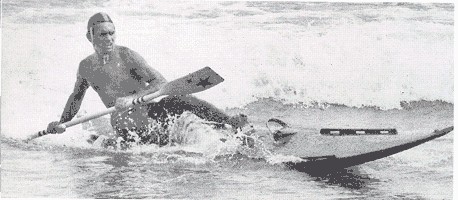 |
|
One of "Daffy's" secret weapons came unstuck, Clifton Beach, Tasmania, Australian Championships venue, 1969. |
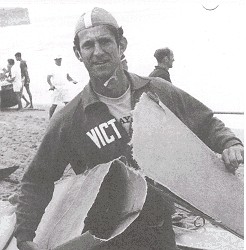 |
Chapter 10: Surfboards - "The Long and the Short"
| Page 101
Vic Tantau holding solid redwood board owned by Phillip Bennett, 1937. |
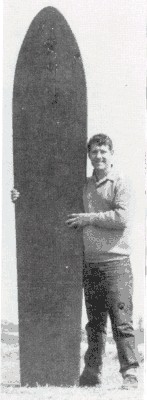 |
From 1915 onwards
many of the boards fashioned after the Duke's appeared on beaches throughout
Sydney.
The late "Snowy"
McAlister, also from the Manly club, won Australian Board champion exhibitions
in the 20s and 30s on a similar board.
It has never
been clearly documented the year the longer, lighter, hollow boards came
into vogue, but they began appearing on Sydney beachs from the early 30s.
Various boat
builders in the 20s had manufactured hollow boards to the shape of the
Duke's using assorted plys, but they never seemed to handle as well as
the solid types.
They were also
damaged much more easily on rocks and often split their seams when struck
by heavy surf.
However by 1938,
boards in use were predominantly of the 12'-16' hollow type made from strong
marine ply, lhl! cedar sides, rails along the edges, hook at the back and
a bung in the front to enable water to be drained out.
Records are not
available to show precisely when the riding of waves on boards took place
in Victoria, either in the bayside or on coastal beaches.
Many bayside
lifesaving clubs had boards, both solid and hollow in the 20s and 30s,
that were mainly looked upon as so much flotsam and rarely used due to
their unsuitability in the "washing machine" type of waves experienced
in the bay.
| Page 102
Long boards at attention on Torquay Beach, 1947. Riders from left are: Unknown, John Allan, Barry Patten, Ken Harris, BiU Bennett, Peter Bennett, Reg Gray, Dick Garrard, Keith Putt, Frank Inness, unknown, unknown, "China" Gilbert and Eric Knight. |
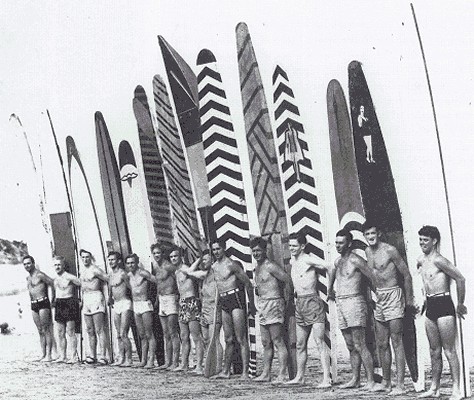 |
Page 103
... Lorne would
have been most suitable.
Vic, in 1980,
was lucky enough to find two of these boards at the home of Lou Whyte's
sister in Geelong.
After negotiations
with the Executors of the late Lou Whyte's will, he was given these boards
plus a few photos from the family album showing the boards in use at Lome.
Vic subsequently
gave the boards to be used for posterity to the Torquay Surfing Museum,
where they are to be held in trust, for viewing by the general public and
for the benefit of future generations.
One of Victoria's
first acknowledged ocean board rider was club foundation member, Ainslie
(Sprint) Walker, who was transferred to Melbourne from Sydhey in the late
20s by his firm of stock and station agents and wool brokers, Grascos Ltd.
Sprint, a former
champion body surfer and surf swimmer from the Manly club, made trips to
Portsea and Point Leo beaches, where he rode a solid redwood board.
He and his fellow
mates from the Melbourne Swimming Club decided the surf at these beaches
was unsuitable for board riding, and on subsequent trips to Torquay they
found the surf far more consistent, safer and rideable.
They decided
to concentrate, all their energies at this "idyllic surfing location".
| Page 103 A
Bigger and better surf skis are adding to the attractions at Torquay, where members of the newly-formed surf club are shown here in a beach line-up. Some of the skis are in the sixteen-footer class. From left; A. Shields, M. Roberts, E Watton, ~ Haroey, R. Galbraith, D. Garrard, L. Scott, E Drenikow, J. AUan (aU of Melbourne), Un Bock, (Torquay) and W Joyce (Melbourne) . Argus Newspaper, 1946. Originally one image, these two images have been cropped and realigned to isolate board and ski ridersm (below). |
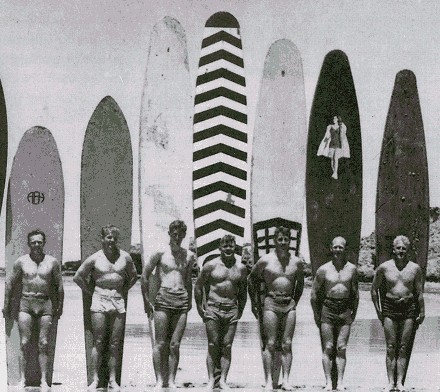 |
| Page103 B
Bigger and better surf skis are adding to the attractions at Torquay, where members of the newly-formed surf club are shown here in a beach line-up. Some of the skis are in the sixteen-footer class. From left; A. Shields, M. Roberts, E Watton, ~ Haroey, R. Galbraith, D. Garrard, L. Scott, E Drenikow, J. AUan (aU of Melbourne), Un Bock, (Torquay) and W Joyce (Melbourne) . Argus Newspaper, 1946. Originally one image, these two images have been cropped and realigned to isolate the board (above) and ski riders. |
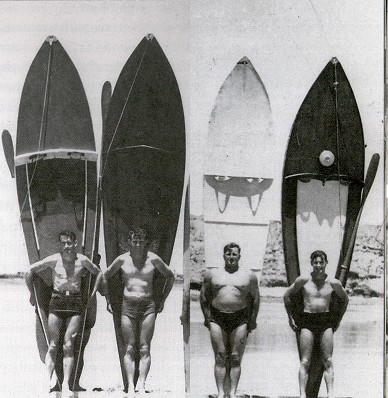 |
Page 104
... a square stern
and, in order to prevent damage on the rocks, was covered in galvanised
steel over the ply.
Again the weight
was a huge problem, but both Vic and Spud used it for some years until
the board which leaked like a sieve, finally sank off Rocky Point.
Dick Garrard,
another V.R.I. man also had solid boards which he rode until graduating
to the hollow 16' type about 1939.
Tony Johannsen,
Phil Bennett, Ron Rayner, Les Haley, Fred Drenikow, Jim Wall and many others
all tried out board riding, to a lesser or greater degree, but it appears
that Vic Harvey, Spud O'Hara and Dick Garrard were the top board riders,
showing the most skill on the perfect Torquay waves.
However, it wasn't
until the end of the Second World War and the formation of the surf club
in 1945 that surf board riding became more popular.
By now only long,
mainly 14/16' hollow boards were in use.
With the formation
of Victorian State Centre in 1947, surf carnivals were introduced onto
the coastal scene and surf board paddling races became a well contested
event.
Members purchased
boards from Sydney builders, Bill Wallace, Gordon Bennett (sic, Gordon
Woods,
Barry
Bennett), Bill Barnett and local builders, Col Downey, Bernie Main, George
Evans, Laurie Nelsson and Bill Clymer.
The boards fast
became "works of art" as construction methods improved with the use of
stronger, lighter ply, copper nails, waterproof strong gripping glues,
better shaping of frames etc.
Shaped sides
and bottoms with increased "banana" in the overall length helped eliminate
nose diving or "going down the mine", as it was known.
Many of these
improvements were brought about in an endeavour to make them more suitable
for paddling races, which were becoming most important in Surf Clubs throughout
Australia.
It must be kept
in mind that up to the end of 1960, these same racing boards, mostly 16'
long, 18" wide, weighing approximately 351bs, were also used for riding
waves.
Even though the
long boards, particularly now designed for paddling races, were difficult
to handle, members from the club put on spectacular displays, catching
waves more than 500 yards out to sea and cornering from one side of the
beach to the other until finally the break caught them or they hit the
shore.
There is no doubt
that the two men who set he standard for surf board competition here in
Victoria were club members Rex (China) Gilbert and Vic Tantau.
"China" won the
first four (4) Victorian 16ft. board titles, 1948 to 1951 and Vic the next
five (5) 1952 to 1956.
Both competed
at Australian championships during this period against the great board
men of the era - Keith (Spas) Hurst (North Bondi), Roger Callan (Coogee),
George Bishop, Ron Hazelton and George Edwards (Maroubra), Trumper Bevan
and Wilson (Coogee), Serge Denman (Bronte), "Stretch" Nicholls and "Bullets"
Henderson from Freshwater, to name a few.
Both reached
the finals in various years, with Vic coming the closest to winning an
Australian medal when he vas placed fifth at Scarborough, WA. in 1951.
Their training
throughout the summer months with long paddles in the bay, on Albert Park
Lake, and in Vic's case, on various lakes around the Geelong district,
kept them in superb condition.
On weekends at
Torquay they thrilled the crowds with their skilled riding of these huge
boards, on any size wave in any conditions.
| Page 104
Best known surfing "character" in Australia, "China" Gilbert, in a relaxed pose in full control of his 16ft Surfboard, Torquay Xmas, 1947. 'Pioneer' board rider; Victorian Long Board Champion, 1948- 49-50-51; Club 16ft Long Board Champion, 1948-1950. |
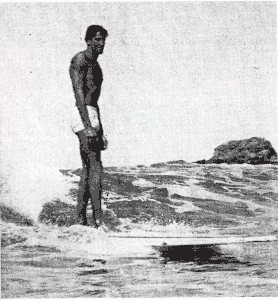 |
| Page 104
Four redwood solid surf boards brought from Hawaii in 1919 by Lou Whyte and used by him and others mainly at Lome early 20's. Two of these boards now in Torquay Surf Museum. |
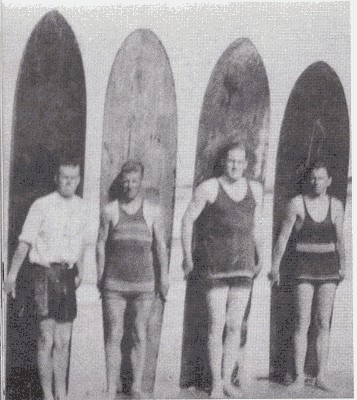 |
Page 105
... State and
Club board championships and repeated that performance again in 1954.
Vic, "China"
and "Emmo" were magnificent exponents of the sixteen foot surfboard.
It was a privilege
indeed to have witnessed their wave riding ability and the I high standard
they set in competition against each other in board paddling events.
Aub Cherry joined
the club during 1950 and quickly became a most proficient board paddler
and rider.
He was placed
second in the 1951 State and Club board titles and was selected in the
State Team to tour Tasmania that year.
Aub was elected
the club's first Board and Ski Captain in 1951 and held that position until
the end of the '55 season.
For three of
these years Kevin (Mumbles) Walker was his deputy.
He was placed
third in the State Title of '53 and then at the Southern States Championships
in January 1954, won the inaugural novice board race.
George (Ming)
Smith an "excitable" character put up some good performances on the board
during the early 50's.
He won the club
marathon board paddle - Torquay to Breamlea - in 1953, was third in the
State Title in '54 and second in '55.
"Ming" has been
credited with winning the first ever prize money at a board rally, when
in 1961 at "Bells", he was awarded £1 ($2.00) for riding "the wave
of the day".
Jimmy Bell was
another good board man in that same era, '50-'55, competing in many surf
carnivals and club events during that period.
He won the 1954
State novice board event and was second in the State Open Title in big
dumping seas at Anglesea 1956.
With "China" now concentrating on surf boat competition, "Emmo" transferring to Lome, Vic facing retirement due to serious knee problems, Aub off to Canada, Jimmy Bell retiring and "Ming" seeking out other ...
Page 106
"ventures" a new
group of paddlers was emerging.
During 1952 two
youngsters, Peter Troy and Jon Myers, who both lived in Torquay, joined
with an influx of cadets.
Both became fine
junior competitors in swimming, R & R and board events, and by 1955
they began to excel in board competition.
Peter had been
riding waves on boards at Torquay from an early age.
His father Col
ran the local news agency and after Peter had delivered the morning papers
to the campers, he would head off for the beach.
By the age of
twelve he was a most skilful wave rider, amazing the many spectators with
his daring manoeuvres on his fourteen (14) foot, white painted board.
Jon competed
in all club board and swimming races from 1954 to 1957 gaining places in
a variety of handicap events.
During 1955-56
he and Peter shared many of the board race victories between them, with
Peter winning the State novice board title and Jon gaining third place
in the open title during that "Season".
In fact, during
January 1956 Peter became the first person to beat Vic Tantau in a board
race in four (4) years.
In 1956/57 Jon
aged twenty was elected club vice captain and when "China" Gilbert, club
captain at the time, was injured in a motor vehicle accident, he carried
out the duties as acting club captain; the youngest person to fulfil this
most responsible position in the club's history.
He resigned at
the end of 1958 to pursue his business activities in the oil fields of
New Guinea and in later years, Saudi Arabia.
Peter went on
to win the State board title in 1961 and 1962 after having been placed
second in 1958-59 and '60.
During his career
he was selected in the State Team in 1960-1961-1962 and made the final
of the Australian surfboard championhip in '56-60 and 61.
He won a number
of club swim and belt titles including the long board title in 1958-1961
(equal 1st) and 1962.
From the middle
60s onwards Peter travelled the world competing in Malibu board riding
competitions in France, South America, U.S.A. and Hawaii.
His name is synonymous
with surfboard riding throughout Australia as a result of his surf movies
and his involvement as Historian of the National Board Riders Association.
He was a driving
factor behind the establishment of the surfing museum in the town of Torquay.
A wonderful ambassador
indeed for his great love of the sport of surfing.
| Page 106
One of Torquay's finest exponents of both 16ft long boards and Malibu boards, Peter Troy. State Long Board Champion, 1961,1962. Club Long Board Champion,1958,1961, 1962. Pioneered the introduction of Malibu board. Riding at Bells Beach, 1957. |
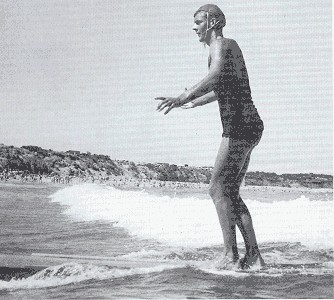 |
Page 107
... with a perfectly
flat sea between one and two metre green, rolling waves.
Aged 25 and in
the peak of condition after a season of strenuous training, he took off
like a rocket at the sound of the gun straight through a breaking wave
which swamped most of the other hesitant competitors.
Paddling strongly
in the flat sea he reached the first buoy more than fifty yards in turning
the third buoy he increased his rating and cracked a beautiful green wave
almost to the shore.
A most convincing
win, reminiscent of many of Vic Tantau's victories.
He won the club
board championship in 1960 after having been placed on a number of occasions.
Dick, nicknamed
the "Whip" for always straining to get the most out of his training sessions,
his catch call being "whip your body", was one of the four Knight boys
who joined the club in the '50s - Dick, Tony, Eddie and David.
Eddie was a most
competent R & R man, following in his brother Tony's footsteps, who
was an excellent all round surfer.
Tony competed
in surf race, belt and board events as well as his many R & R feats,
outlined in other pages.
He gained places
in a number of board events, including club championships and was third
in the State Title in 1958.
Torquay had many
members during the 50s who rode the waves and were prepared to race these
long boards, when their other major events permitted them, as well as a
number of specialists who were always in there trying.
These included
Alan Reid, Neal Inglis, Joe Sweeney, Bernie Main, Jack Barry, Des Couch,
Ross Jenkins, Ray Pettigrove, John Hughes, Bill Waddell, Trevor Lobb, John
Fay, John Ross, Eddie Hogan and Bruce Granger.
| Page 107
Ken Pollard seen here taking a breaking wave to victory in the 1958 State Championships at Lome. Victorian 16ft Long Board Champion, 1957-1958. Club 16ft Long Board Champion, 1960. |
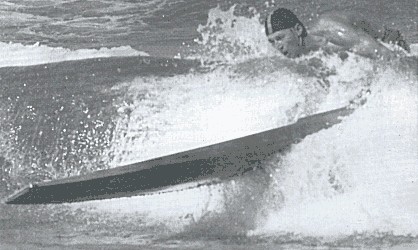 |
The "Whip", however,
was a board specialist who excelled in the choppy conditions experienced
year after year at all venues.
He was short
compared with many tall, long stroking paddlers of his era; but his pace
off the beach and his strong short revving strokes won him innumerable
board races, often on borrowed boards. The "Whip" was a "real character",
who like his brother Tony seemed to be always attending some university
course.
At one time he
purchased a "one man boat" built by Bill Clymer and could be often seen
cracking, or at least attempting to crack, the dumpers in the middle of
the beach.
The boat had
to be sold when "Whip" became strapped for cash (which seemed most of the
time) to pay his university dues to finally finish his architectural course.
He later tried
his hand at surf-boat sweeping at the Portsea Club, when he failed to break
into the Torquay crews.
Page 108
He won the State
Board Title in 1959 and 1960, both in wild choppy seas and was second in
1957 and 1961.
It was a period
when Torquay members Pollard, Troy and "Whip" were placed first, second
and third race after race.
He trained extremely
hard on the Bay at Elwood during the summer, which resulted in him making
the State Team to Mooloolaba Queensland in 1959.
He made the final
of the Australian Board Championship that year and at Moana in 1961.
The State Centre
introduced Malibu board races in 1961, in an endeavour to give the growing
ranks of this popular board some competition.
Dick won the
first State Title, though it was originally classified as a non-championship,
in 1961 and then again in 1962.
His club championship
wins included 1959, equal 1st 1961 and equal 1st in the Malibu 1961.
In 1956 an American
lifesaving team on their way to compete at Torquay beach for the Olympic
and International Carnival, stopped off at Sydney.
They had with
them a number of boards which, though completely foreign to the locals,
were similar in shape and size to the Duke's old board.
The Americans
referred to these boards as "Malibus".
They were about
9ft. long, 22 inches wide, 3 inches thick and made from balsa wood covered
with fibreglass.
Unlike the earlier
solid boards, these Malibus had a large fin on the bottom near the back,
which helped to keep the board stable, eliminating skidding on a wave and
aiding their manoeuvrability once the wave was caught.
The Americans
demonstrated their ability with these boards in exhibitions they gave at
the Sydney beaches of Manly, Avalon and Bondi.
The dexterity
and skill they showed in riding them amazed the Sydney club members and
others, who had come to scoff at these "Yanks" "who wouldn't be able to
teach us anything about board riding".
The locals were
quick to copy these boards, which were destined to revolutionise surf board
riding throughout Australia.
Page 109
A new group of
young board men began emerging from about 1960 onwards, who became experts
in riding these Malibus whilst competing for the club on the 16ft board.01
Amoungst them
were Terry Wall, Jeff Watt and Eddie Beacham.
Terry was skilled
in all facets of surfing, winning the inaugural "Jim Wall Memorial Surfathon",
named in memory of his father, in 1964 and again in 1965.
He won the State
Malibu title in 1963 and the club long board title the same year.
Board relay teams
were introduced in 1965, and the team of Terry, Jeff and Eddie won both
long and short board State Titles in 1965 and the Malibu team of Doug Warbrick,
Maurice Rayner and Bryan Hayden, won the title in 1966.
Jeff Watt was
second to Terry in the State Malibu title in 1963.
Terry won the
State Malibu Title again in 1964, with Jeff winning it in 1965.
Terry went on
to win the Club long board title in 1964 and 1965 and the Malibu title
in 1962 (equal with Ed Beacham), equal 1st with Jeff Watt in 1964, then
first again in 1965 and 1966.
However, the
dominance that Torquay paddlers had in the long board event from 1948 to
1962 was over.
| Page 109
Boards being displayed by American team during their visit in 1956 for international carnival at Torquay. |
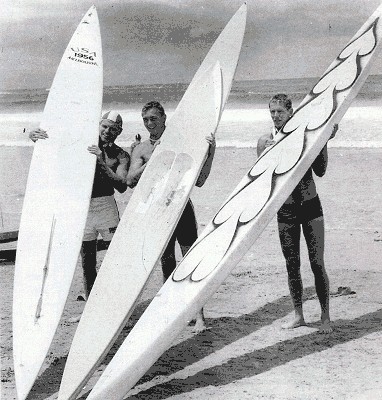 |
These three board
paddlers were the most successful trio in the club's history, winning the
State long board relay title in '74 and '75.
Stephen, Chris
and Paul White in '73 and Peter, Stephen and Paul in '70 and '72.
The trio of Stephen,
Peter and Chris won the State Malibu title in '71, '72, '73, '74 and '75
and bathed themselves in further glory when they won the Australian long
board and Malibu teams championship in 1974 and 1975.
Peter stamped
himself as Torquay's finest board paddler ever by winning the Australian
Long Board Title in 1974 and 1975 and the senior Malibu Australian Title
in 1974.
Ken Goulding was
a consistent competitor in the late 80s and into the 90s, winning the senior
Malibu State Title in 1988, 1990, 1992 and 1994.
The fine all
round competitor Brett Tyack won the same event in 1989 and 1992.
After the introduction
of the "Malibu" in 1956; it took only a few years before the use of 16ft
boards were strictly for competitive paddling.
From the late
60s the manufacture of the long board had changed dramatically.
No longer built
with timber and ply, they were pressed from foam moulds then coated with
fibreglass sheeting.
Shaped fins had
been fitted on the timber hollow boards some vears before to make them
more stable but these moulded boards had knee wells, foot controlled rudders
and weighed about 25lbs. With the decline in their use, the long board
was dropped from competition at the end of 1986. However, Malibu board
racing still attracts many competitors.
Another very fine
long and Malibu board paddler, Wayne Bacon, won his first club championship
junior long board in 1976, the first of his many club board titles which
include club senior long board champion 1979 to 1983 (five), club senior
Malibu champion '79, '80, '81, '82, '83, '88, '89, '92, '93, '94 (ten).
Wayne has competed
in board events for the past eighteen ...
Page 110
... years, for
longer than any Torquay member and has been placed many times in State
long board Malibu races, plus board relay teams,
Torquay members
have been most successful in long and'Malibu board teams events at Victorian
and Australian Championships since their introduction during the 1964/65
Season as the following list indicates:-
...
Pages 111-112
Placings in Longboard
and Malibu Competitions.
...
Page 135
The history of
the Torquay S.L.S.C. would be incomplete without a brief reference to the
involvement of club members in establishing the now world famous Bells
Beach.
This beach, located
approximately 6 kilometres due west of the clubhouse, gives one the feeling,
when looking down from the surrounding cliff tops, that you are viewing
a large amphitheatre.
The same feeling
is also sustained when looking up at the encircling cliff face from the
waters edge. The natural beauty of this beach, at any time of the day,
has a wonderful magic secluded feel of its own.
The views from
the cliff tops when the "Bells Boomers" are rolling majestically in from
the Southern Ocean, is one of awesome power and beauty.
| Page 135
The glory of Bells. Photo courtesy of Jack Finlay, Torquay Surf Museum. |
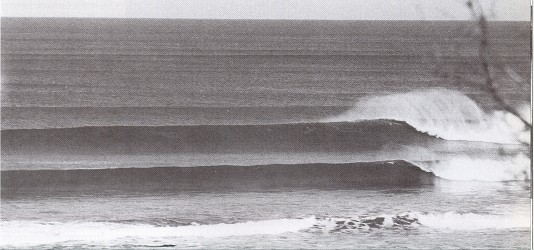 |
Page 136
... declaration in Australia, perhaps the world!! - and so the myths and conjectures add their allure to this "Mecca" of surfing.
It is not the writers intention to answer or add to these queries, other than to put the club members early involvement with Bells Beach to the reader, prior to its surge in popularity in the early '60's.
From 1905 up until
the 1939-45 Second World War, there is no record of any early Torquay surfer
going anywhere in the district to "bodyshoot" or board ride, other than
the front beach where the first lifesaving club was established or the
surf beach (where the present surf club is located).
The odd visit
was made by the surf beach "daredevils or fools' depending on many a locals
impression of the 1939's surfers to the back beach now known as Jan Juc.
At Jan Juc it
was sometimes possible to catch a wave when conditions at the surf beach
were dormant.
What's new -
they could easily be looked upon as the original wave chasers!!
| Page 136
Peter Troy and Terry Wall prior to 'cracking a few' at Bells Beach, 1961. |
 |
The beaches right
along this area are quite spectacular with the waves at the various Points
located here, often rolling even and green.
Access to the
great majority of these Points was impossible because of the sheerness
of the cliffs. Even at low tide the rocks at the base of the cliffs and
in the water made surfing there look fraught with danger.
These circumstances
can still be viewed today.
Bells Beach,
though for the initial years nobody really referred to it as ...
Page 137
... such, just
as it is a fact that many of the Points and beaches in the area had gazetted
names which few knew about or cared, at least was approachable.
A rough track
ran right down to the creek area near the beach itself.
It was then only
a scramble down the dip, over the rocky tea tree strewn area and down onto
the sandy beach.
This is the spot
where the stairs are now built.
Having reached
the beach many of the bike riders would furtively enter the water and crack
the odd body wave near the shore, never out to sea, then look for crayfish
around the rocks at the cliff face during low tide.
There was no
mention or desire to drag a sixteen foot board or ski around here to ride
for the surf at Torquay beach completely satisfied all of the "plank" men's
needs; the riding and racing of the bikes, to them, were the day's thrills.
There was another
access to Bells other than using the old Cobb & Co dirt road, which
the bikies rejuvenated along the cliff top.
This Cobb &
Co track turned inland from the cliff top before the dip into the creek
bed around where the concrete wave is now located and meandered its way
into the small Bellbrae township, then onto Anglesea.
There was a reasonably
graded dirt track, (later gravelled) running off Anglesea Road right down
to Point Addis.
During the war,
this road had been prepared and maintained to enable the sighring of gun
emplacements around the Headland at Addis in the event of an invasion by
the Japanese.
Years before
that, a track had run from the Anglesea Road through to a large red ochre
mine located in the Iron Bark Gully.
This road then
extended down to where Southside Beach is located where it stopped for
some unknown reason.
It may have been
built to gain access to the creek water for mining purposes.
It took quite
a scramble to get from this road onto Bells Beach proper and was therefore
infrequently used by the early (1957 onwards) surfboard riders.
The final approach
to Bells was by obtaining permission from the farm qwners near the Anglesea
Road, where tracks ran to their properties and then on down to the cliff
tops.
| Page 137
Ian Seeley cracking a ripper at Bells Beach (circa 1970). |
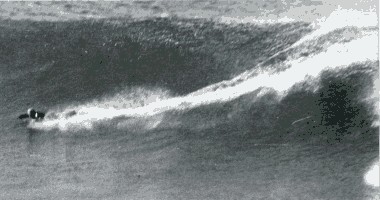 |
| Page 137
'Kit' Carson and Bryan Hayden surfing Bells, 1970. |
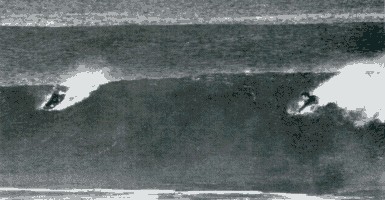 |
Between 1952 and
1956 many young men from the bayside suburbs of Melbourne joined the club.
Quite a few had sporty M.G. cars, but there was no way that they were going
to take these low slung vehicles off the bitumen roaring around rough dirt
tracks in search of surf.
Most were "paying
off" these expensive items and they were often short of the "readies" -
thus any added outlay for repairs, or even extra petrol was an enormous
strain on their resources.
Another deterrent
to trying out ...
Page 138
... the waves
at Bells, apart frqm the effort to get the monstrous long boards there,
was the fact that club members owned one board only.
They competed,
trained and rode the Torquay surf on it, often for a minimum of three years
per board and if they damaged this board in any way, they were left riderless
until often elaborate repairs were effected.
The introduction
of the short Malibu board to Sydney, then Torquay during the visit of the
Americans to compete at the International and Australian Championship Carnivals
at the Torquay beach, during November/December, 1956, revolutionised board
riding and board design from what was known previously.
This was not
the first time that this type of board was seen on beaches in Sydney.
Hollywood actor,
Peter Lawford, used one during 1954 whilst on location there during film
making but for some unexplained reason, maybe the timing was too soon,
no one seemed to care. Apparently from reports recorded at the time, he
rode the board with equal flair and skill to that shown by the "Yanks"
during 1956.
During their visit
to Torquay, the small surf and the limited time at their disposal did not
permit the Americans to display their board riding skills to any advantage.
However, their
display on the Sydney beaches, like that of Duke Kahanamoku in 1915, set
the locals on fire.
They sold the
boards to surf club members on their departure and within a few weeks,
copies were on sale in Sydney.
Once again the
writer has no intention of getting into the debate of the manufacture,
cost, materials used, or who rode the first Malibu regularly at Torquay
beach or where the boards came from.
Suffice to say,
Malibu boards began to appear at Torquay in small numbers during the 1957/58
season.
As in the past,
it was only surf club members who used the boards - this of course was
soon to change.
The Malibus were
definitely harder to paddle than the sixteen footers and it took a lot
more skilled effort to catch the slower, greener waves off the Point.
Many found it
difficult to "crack" and hold the waves, coupled with the added hazard
of skis and longboards flashing all around and often forcing them off the
few waves they caught.
There was a definite
feeling amongst the established "plank" men of the time that these new
boards had their limitations, hardly worth the effort to learn to ride,
and the "craze" would soon wear off anyway.
A number of the
Malibu owners and borrowers decided to seek a beach where the waves were
steeper giving a rider a greater certainty of catching them.
They also wanted
less arduous paddles to the take off point, plus the added bonus of no
interference from skis or longboards.
Bells Beach was
remembered by Peter Troy, who had lived in Torquay most of his life and
had gone there on a few occasions over the years, so he and his mates began
to use the tracks and ways of getting to Bells, already outlined, at frequent
intervals throughout 1958 and 1959.
The majority
settled on the direct route from the club around the top of cliffs, with
a reasonable walk at the end, where the road became difficult to negotiate
through "the dip".
They found that
the Bells Beach waves were perfect in every respect for the short boards
and an added attraction was that the waves at Bells were often two or three
feet steeper than the Torquay Point.
By 1959, Bells
Beach had grown steadily in popularity, to a far wider group of surfers
other than strictly surf club members, as the allure of the surf to be
regularly gained there began to spread.
In 1960, Joe Sweeney,
a champion surf swimmer, excellent long and short board rider and one of
the original riders at Bells, obtained permission from the Shire Engineer
of Barrabool Shire at the time, Ron Spence, to upgrade the old Cobb &
Co road and extend it further into the Bells area.
He hired Lance
Altman, a local contractor, who used his grader to widen and consolidate
the track through the dip over the other side where the concrete wave now
stands and right down to where the car park is now.
The grader uprooted
stones, grass tussocks and small trees fairly easily, and spread the rough
red ...
Page 139
... gravely soil
into an even track.
The work cost
Joe £32 ($64) and with his mates Neal Inglis and Peter Troy he endeavoured
to raise the money at a £1 a time from the first users of the new
track.
It is still not
sure if Joe raised the money, for surfers, particularly then, were always
short of money and most had "death adders" in their pockets, or so it seemed.
The track certainly
opened up Bells Beaeh rapidly to a wider range of board rider and their
friends. Over the ensuing years with the elements creating steady erosion
and increasing traffic, particularly during the winter months, causing
large furrows, the track became quite an adventure to negotiate.
There is no doubt
that the 60s put Bells Beach firmly on the map as one of the finest surfing
beaches in the world.
During this time
Torquay club members established a Board Riders Association, pioneered
the use of wet suits, and set in place board riding competitions, whilst
still maintaining their surf club commitments.
Terry Wall, Brian
Singer and Doug Warbrick set up the first surf shop in Torquay around 1968
and other surf shops began springing up at other beach locations.
Vic Tantau, previously
an agent for Clymer boards from Sydney, began to manufacture boards, from
his home at Moorabbin and "Doc" Hughes' old kiosk at Torquay and then from
a factory in Chesterville Road, Moorabbin about 1959.
Vic and Peter
Troy organised the first board rally held at Bells in 1961, and in 1963
the now world famous Bells Beach Easter Rally was held.
Torquay club
members were successful in board riding competition against the many Interstate
riders who were coming down from N.S.W. and Queensland to test out what
they had heard about the "Bells Boomers".
Jeff Watt, Terry
Wall, Colin, Jett Watt, Terry Wall, Colin McDonald, John Gudgeon, Doug
Warbrick, Brian Singer, Pat Morgan and Rod Brooks in parricular, all featured
at intervals in the early Victorian Board Riding Championships and Easter
rallies.
In the veterans
class Brian Lowden, Joe Sweeney and Alan Reid put on some fine performances.
Peter Troy was the first club member to establish himself internationally,
competing in England, France and South America, whilst on his world travels
in the early 60s.
Membership of
surf clubs began to drop away as the young bucks preferred chasing waves
around the coast, to patrolling beaches and club captains "Doc" Jones,
then Neal Inglis, had the irksome task of castigating and often suspending
members who took off for Bells when they should have been patrolling the
Torquay beach.
The Victorian
State Centre were quicker than their interstate counterparts and introduced
Malibu board paddling competition as early as 1961, in an endeavour to
retain these board enthusiasts as club members.
By 1966, the
initial craze had subsided a little and the animosity ...
Page 140
... between surf club members and board riders began to ease, as they endeavoured to work more closely together.
For many years
now the Torquay township has been the hub of the surf board, wet suit,
sail board and clothing manufacturing industry in Australia.
Brian Singer,
Doug Warbrick, Rod Brooks and Fred Pyke all went on to be a majorpart of
this industry which has given employment to dozens of locals and brought
millions of dollars into the Victorian economy.
The Bells Beach
Easter Rally is a vital cog in the world professional board riding circuit
and thousands of spectators throng to Bells to witness what has become
the longest running board contest in the world.
Who could have
visualised that from the desire of a few club members to seek out a beach
to indulge their passion for uninterrupted board riding sessions, that
all this would eventuate..
| Page 140
Early ad for "Singos" and "Claws" (Rip Curl) gear in club magazine, Nov., 1968. |
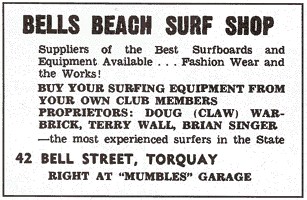 |
|
History of Torquay Surf Life Saving Club : the first fifty years, 1945-1995. Torquay Surf Life Saving Club, Torquay, Victoria, 1996. |
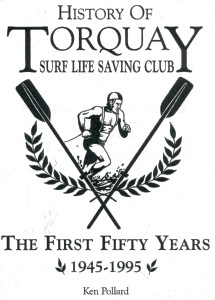 |

| home | catalogue | history | references | appendix |